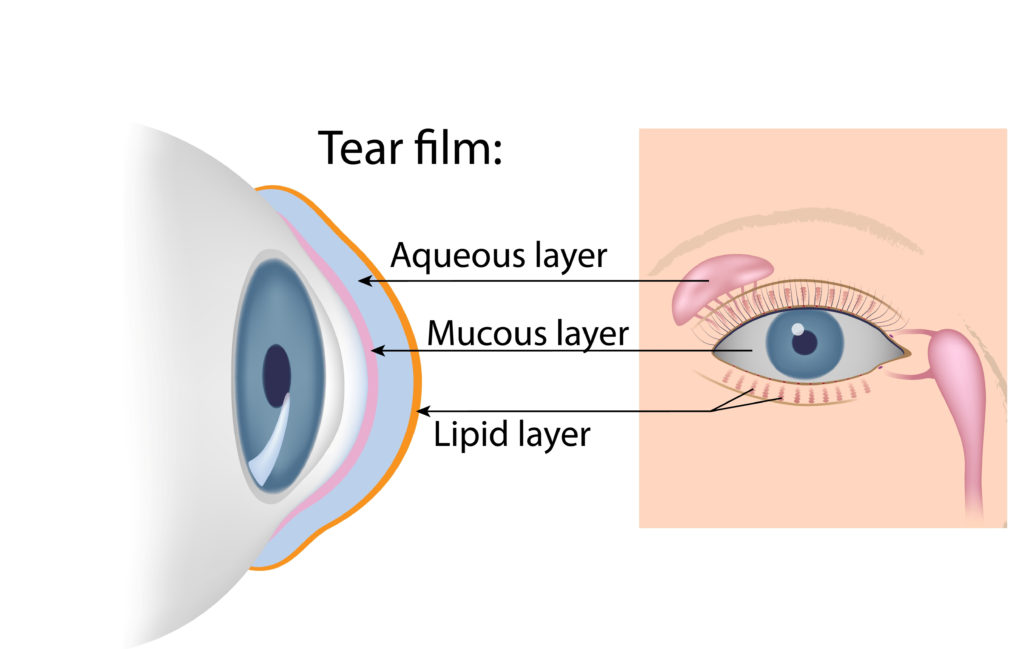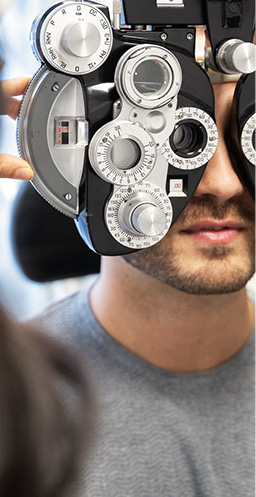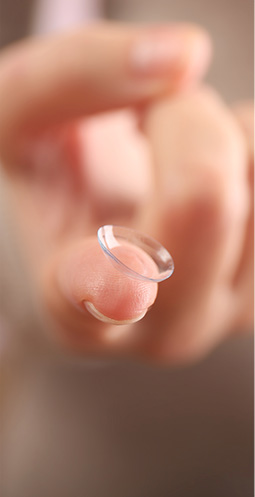Do You Have Dry Eyes?
An incredibly common condition, dry eye syndrome (or dry eye disease) is characterized by an instability of the layer of tears that hydrate the front surface of our eyes. This layer of tears is also known as the tear film. While an unstable tear film is ultimately what causes dry eye symptoms, underlying issues can trigger tear instability.
Our eyes are protected and kept moist by the tear film. This substance is comprised of three main elements: aqueous (water), oil, and mucous. All 3 components are produced by different glands surrounding the eye.
In this article, we’ll explore what happens when the tear film fails. We’ll also take a look at how to alleviate the resulting symptoms and get your eyes comfortable again with dry eye therapy.
Symptoms of Dry Eye Syndrome
Unfortunately, many people who experience dry eye syndrome may not even realize that it is a manageable issue. The symptoms are so varied and common that a variety of treatments have been developed to address them all.
Note: Symptoms that come and go could be due to environmental triggers or allergies. However, even if dry eye syndrome is exacerbated by things like dust or dry climate, your symptoms can still be treated.
Itchy, Burning, & Aching Sensations
If you are constantly rubbing your eyes in an attempt to relieve them, this is a solid indication of dry eye syndrome.
Individuals experiencing these types of sensations might relate them to the feeling of getting soap or dirt in your eyes. Or, your eyes may feel more aching and sore than sharply irritated.
Another common symptom is what is known as a “foreign body sensation” or the feeling that there is something in the eyes, when in fact there isn’t. Sandy, gritty and burning are often words patients use to describe how their eyes feel.
Red, Watery, & Tired Eyes
Sometimes, dry eye disease is characterized by excessive amounts of tears rather than a lack of them. This is because the tears are missing an essential component, usually the oily lipid produced by the meibomian glands. The oily lipid is called the meibum and is an extremely important component of our tear film because it keeps our tears stable.
Red eyes are caused by blood vessels in your eyes becoming irritated and inflamed. Redness, as well as the feeling of tired eyes, are a result of chronic low-level inflammation due to the instability of the tear film.
Visual Fluctuations
You might not believe it, but even vision problems can be a result of dry eye syndrome. These include a greater sensitivity to light (photophobia), getting headaches, or needing to squint when doing visually demanding tasks.
Blurred vision is another issue caused by dry eye syndrome. This is because your tear film is instrumental in providing clear sight. When it’s lacking in certain components, it cannot be distributed across the eye evenly, as required for clear vision.
Long-Term Effects
Dry eye disease could seem harmless enough, but the truth is that it is linked to other serious issues. If severely dry eyes go untreated, it could cause corneal damage.
Dry eye disease has also been linked to issues such as depression and anxiety due to the impact it can have on your quality of life.
What’s the Cause?
As we’ve already touched on, dry eye disease is mainly caused by a lack of sufficient tear film to the eyes. However, what causes the lack of lubricating tears can vary.

Meibomian Gland Dysfunction
Meibomian glands are responsible for the production of the oily component of tears. For some individuals, these glands may become plugged. An indicator of this type of dry eye is that your eyes are excessively watery; they may be producing more of the aqueous component in an attempt to compensate and keep the eyes moist.
A reduction in our blink rate or incomplete blinking can cause the meibomian glands to become plugged. Every time we blink, the meibomian glands release meibum into our tears. With reduced blinking, the meibomian glands may become clogged over time. Some glands can even completely lose their function. Digital device use has been shown to decrease our blink rate by up to 50-75%, which can lead to chronic dry eye syndrome.
Reduced Tear Production
Our tears may completely slow down in their production for several reasons. It could be a certain medication (including antihistamines, decongestants, and antidepressants) or simply a result of ageing.
Alternatively, some individuals may find that they develop dry eyes after laser eye surgery. Or, damage to an individual’s tear ducts (caused by trauma, inflammation, or radiation) can also slow tear production.
Tear Evaporation
If someone’s tears are evaporating too quickly, it is usually due to an external factor. These can include environmental factors such as a dry or windy climate, or excessive smoke.
Other factors of increased tear evaporation include reduced blinking, which is common in cases of digital eye strain. Reduced blinking can also happen when reading, driving, or performing other detail-oriented tasks. Individuals who work jobs requiring prolonged visual focus may experience this type of dry eye.
Dry Eye Therapy
Thankfully, because dry eye syndrome is such a common disease, many different types of therapy and treatment have been developed.
Eye Drops
There are many different eye drops available to combat dry eyes, and It’s important to note that not all drops are the same. Some are more effective than others in their ability to stabilize the tear film. Over-the-counter eye drops from the drugstore often don’t help to stabilize the tear film and only provide temporary relief.
When choosing eye drops (also referred to as artificial tears), preservative-free drops are generally preferred. They are more gentle on the ocular surface, which is especially important for dry eye patients. Premium eye drops, such as Thealoz Duo and I-Drop Pur, can provide long-lasting relief.
Prescription eye drops may be recommended by your eye doctor for more severe cases. Steroid drops may be prescribed on a short term basis to reduce the inflammation symptoms of dry eyes. For use in the long-term, prescription drops such as Restasis or Xiidra can be used.
If you are experiencing a particularly severe case of dry eye disease that is not responding to any other treatment, autologous blood serum drops may provide relief.
Nutritional Supplementation
Omega 3 fatty acid supplementation has been shown to improve meibomian gland function as well as symptoms associated with dry eye. More specifically, EPA and DHA, which are both omega 3 fatty acids, have anti-inflammatory properties that help with dry eyes. Omega 3 supplementation has also been shown to benefit cardiovascular health, brain function, and joint health.
Therapeutic Dry Eye Heat Masks
Dry eye heat masks, such as Bruder Masks and I-Relief Therapeutic Masks, followed by massaging of the eyelids can relieve mildly clogged meibomian glands and restore the oily component needed for proper tear production. The key is sustained heat at a particular temperature for at least 10 minutes. While a warm face cloth may provide some relief, it is not usually sufficient as it tends to lose its heat quickly.
Meibomian Gland Expression
For severely clogged meibomian glands, meibomian gland expression can be a course of treatment. Depending on your needs, your optometrist may use forceps to apply pressure to the lids to open and drain your meibomian glands.
The gland expression is often used in with a heating treatment, such as a Mibo Thermo Flo, Lipiflow, and iLux. These machines use heat to gently break up the gland blockages prior to gland expression.
Blepharitis Treatment
Some cases of dry eye are caused by blepharitis, a condition that causes inflammation of the eyelids. Many treatments are available to manage blepharitis and to help remove the buildup of crusty material it causes.
BlephEx machines are in-office treatments administered by your optometrist to help exfoliate and remove lid debris. Depending on your case, your optometrist may also recommend lid hygiene scrubs, wipes, and gels. Blephagel, Blephaclean, and I-Lid ‘N Lash Plus are some gel and wipe options designed specifically for patients with blepharitis.
Diagnosing Dry Eye
There are a variety of specialized products and treatments, including some mentioned above, that can provide relief to your dry eyes.
At Stoney Creek Eye Care, we use an anterior segment camera to precisely diagnose the health of the meibomian glands. Combined with a detailed analysis of your symptoms, we can recommend the right dry eye therapy for you.
There are many different treatments available. Your optometrist will be able to determine the treatment or combination of treatments that would be most suitable for your unique case. But regardless of how dry eyes may be affecting your life, don’t wait to see your optometrist for fast and lasting relief. It could be easier than you think!









